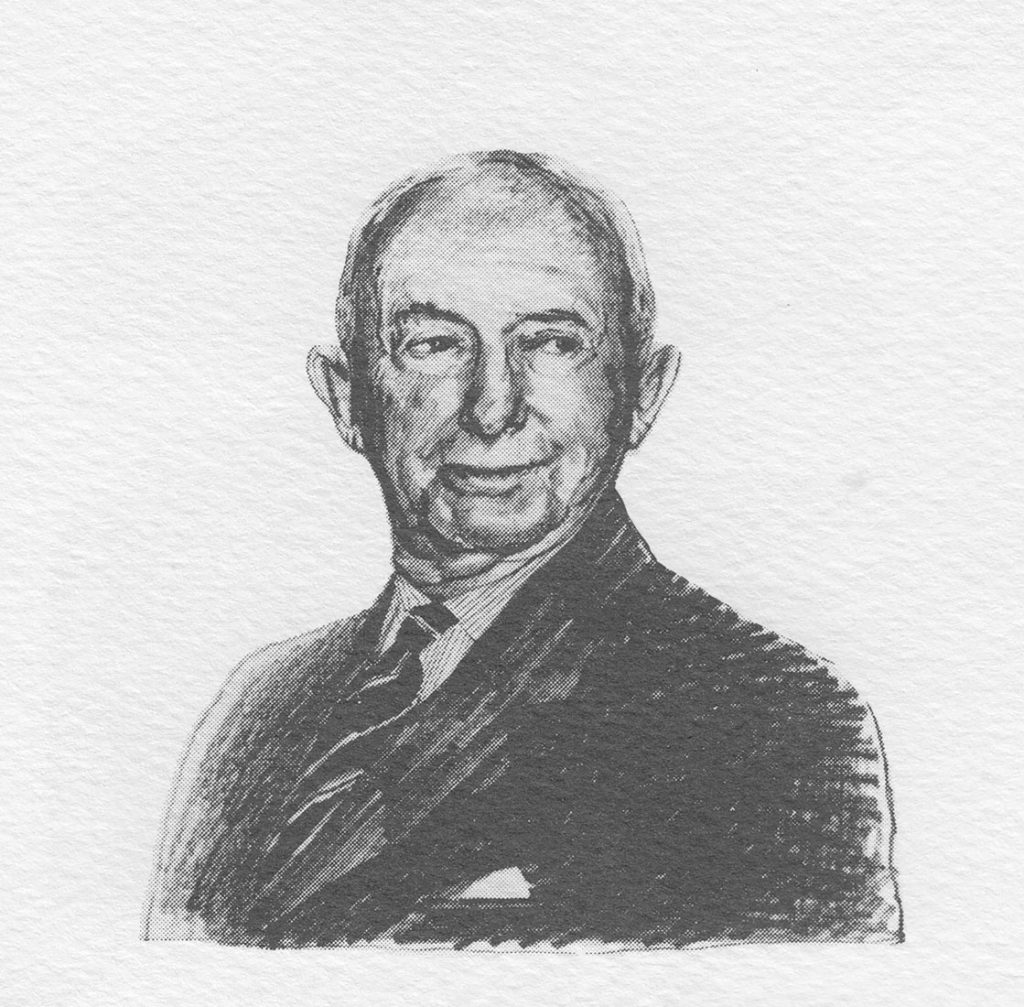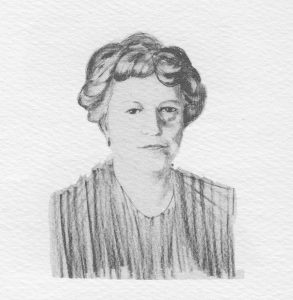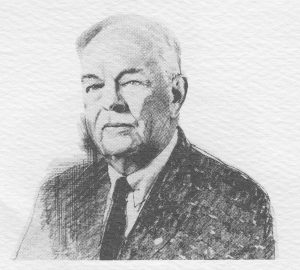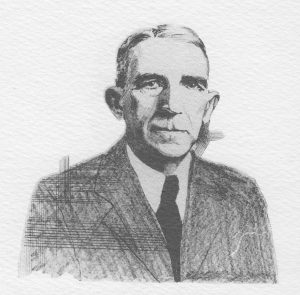Thomas Wesley Martin (1881-1964) was perhaps Alabama’s premier businessman of the twentieth century.
An attorney, utilities executive, economic recruiter, research promoter, and booster for Alabama, he began his long career in Alabama as an assistant in the attorney general’s office in 1903. He was the general counsel, president, and chairman of the board of the Alabama Power Company, an association that began in 1911 and ended with his death in 1964.
Thomas Wesley Martin was born in Scottsboro, Jackson County, on August 13, 1881. His parents, William Logan Martin and Margaret Ledbetter Martin were from pioneer Madison County families. His father was educated at Cumberland Law School, and the family moved to Montgomery in 1889 after Gov. Thomas Seay appointed Logan Martin attorney general to fill a vacancy. Young Martin studied law at the University of Alabama and was admitted to the Alabama bar on December 5, 1901. He then worked in his father’s law practice, where he had as his mentor longtime legislative clerk and Alabama attorney general Massey Wilson, who introduced Martin to the legal issues of dam construction on rivers in Alabama. Together, the attorneys worked on several cases that paved the way for the development of hydroelectricity in the nation.
One of Martin’s most important goals was to improve the economy of Alabama and to increase jobs in the state. He was, of course, in the business of selling electricity and was actively engaged in convincing new industries to locate plants in Alabama to use that electricity. He also was committed to extending electricity into rural areas and directed the most extensive rural electrification program in the South 15 years before the federal government established the Rural Electrification Administration in 1935. Martin supported research grants to determine how electricity could improve the farmers’ quality of life and the profitability of farms and was responsible for the founding of the Southern Research Institute and the state Chamber of Commerce. He was successful in convincing the U.S. Congress to create the Horseshoe Bend National Military Park to commemorate the Battle of Horseshoe Bend.
In 1911, Martin was retained by James Mitchell, a Massachusetts engineer who was planning to build a large dam on the Coosa River. The following year, Mitchell bought out Alabama Power owner William Patrick Lay, who owned the rights to the dam site. Mitchell began construction on the dam, which he would name for Lay, and completed it in 1913. The dam was made operational in 1914, the first step in building an electrical system—generation, transmission, and distribution—in Alabama. In June 1919, Martin married Mary Evelyn Tyson of Montgomery; the couple would have no children.
Mitchell eventually folded his various companies into the Alabama Power Company, and Martin served as general counsel to that company from 1912 until Mitchell’s death in 1920. Martin succeeded Mitchell as company president and began a rural electrification program that same year. He also created a hydrology laboratory at Alabama Power, one of the first in the nation, to assist with dam design. Alabama Power’s second dam, Mitchell Dam, was completed on the Coosa River in 1921. Also in 1921, Martin established an economic development program to recruit new industry to Alabama. And in 1924, he directed Alabama Power to fund research by the Alabama Polytechnic University (now Auburn University) to determine how electricity could increase farm profitability.
Over the next decade, the company would construct four more dams, one more on the Coosa and three on the Tallapoosa River. These facilities provided inexpensive hydroelectricity for the state’s economic development and for the new electrical appliances rapidly appearing in the 1920s. Beginning in 1921, Martin led the drive for interstate electrical connections between Alabama and Georgia, and in the mid-1920s, he was able to form Southeastern Power & Light as a holding company for Alabama Power. Martin organized utilities in four states—Mississippi Power, Georgia Power, South Carolina Power, and Gulf Power companies—and folded them into his holding company. He sent men he trained in Alabama to operate these companies and to develop the electrical systems in neighboring states. In 1929, control of Southeastern Power & Light was acquired by Wall Street investors who merged it with Midwestern utilities and the Tennessee Electric Power Company to form a $1 billion holding company, Commonwealth & Southern (C&S). Martin became the first president of C&S but retained his presidency of Alabama Power, to which he returned full time in 1932.
With the coming of World War II, Martin worked to acquire defense industries and military bases for Alabama, such as the Hollingsworth & Whitney plant located in Mobile and the Childersburg-based plants that produced explosives. After the war, he chaired the state committee that led efforts to convert abandoned facilities to peacetime industries. Convinced that the South lagged behind the North in research, he persuaded other state industrial leaders to join him in founding and funding the Southern Research Institute (now Southern Research) in Birmingham, which was created to make the southern industry more competitive. The facility became active after 1944.
In the 1940s, after the federal Securities and Exchange Commission ruled that Commonwealth & Southern had to be broken up under the Public Utility Holding Company Act of 1935, Martin took a leadership role in creating the Southern Company, which became the holding company for Alabama Power, Mississippi Power, Gulf Power, and Georgia Power by 1949. Martin was adamant that it be a true southern company with a southern board of directors, southern attorneys, and a southern services company headquartered in the South that would provide the engineering services for the operating companies.
In the late 1950s, Martin initiated a second dam construction program that provided electricity for the state’s post-World War II boom. In the 1950s and 1960s, Martin led Alabama Power Company’s construction of dams and generating plants on the upper Coosa River and on the Warrior River. Martin also helped organize the state chamber of commerce to coordinate and promote economic development.
Martin was a lifelong student of U.S. and Alabama history, often researching and writing about topics he was interested in, giving talks, and publishing essays. He wrote French Military Adventures in Alabama (1939) and revised it twice with new information, Doctor William Crawford Gorgas of Alabama and the Panama Canal (1947), Candles in the Canebrake: An Historical Sketch of the Time and Setting (1955), and The Story of Horseshoe Bend National Military Park (1959). In 1913, Martin had urged James Mitchell not to build a dam that would flood the land at the Horseshoe Bend of the Tallapoosa River. In the 1950s, Martin actively pressured the U.S. Congress to create the military park commemorating the U.S. victory, led by Martin’s hero Gen. Andrew Jackson, at the Battle of Horseshoe Bend. He worked with the Alabama Department of Archives and History on many projects and acquired and donated French wallpaper commemorating the Vine and Olive Colony, a nineteenth-century community of French settlers near present-day Demopolis in Marengo County.
For more than four decades, Martin was recognized as a national leader in the electric industry, honored by the Edison Electric Institute, Forbes Magazine, and others. But he never forgot his roots in the mountains of northern Alabama. The driving force of Martin’s life was his love for Alabama and its people and his determination that, as he often said, “the second half of the twentieth century belongs to the South.” He died of a heart attack in Birmingham on December 8, 1964, at age 83. He was buried in the Martin family plot at Oakwood Cemetery in Montgomery.
Biographical information provided by the Encyclopedia of Alabama.






